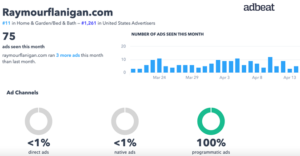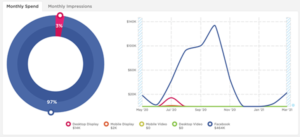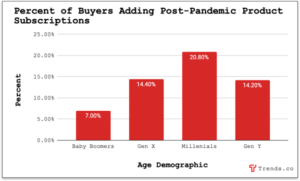Well, the consensus is that if you feel like you and your team have been drinking from a firehose this year- you’re not alone. The industry is booming. And while that’s never a bad thing, it seems client expectations are shifting. There is an influx of high-volume, small to medium-sized opportunities… and high turnaround is a must.
If you missed out on the conversation, get all caught up here. Enjoy!
Hello AAR Agency Growth Program Partner,
AAR Partners has joined forces with Catapult and Winmo to help provide leads for new business opportunities based on the right timing.
But this time, we’ve put science behind the art of prospecting by using data from technologies like Winmo, Pathmatics, and Bombora. This powerful combination helps increase the probability of reaching out at the right time to engage and eventually convert.
This month our research showed a surge of interest within the retail and tourism sectors.
While there are a host of brands/companies looking for agency help, we have isolated two opportunities, for our AAR Agency Growth Program Partners to evaluate, with high intent data who may be in need of some communications support right now.
Retail: Raymour & Flanigan
Located in Liverpool, NY, Raymour & Flanigan is a furniture company founded in 1947. Raymour & Flanigan offers home furnishings in various retail chains throughout the United States. Raymour & Flanigan has shown moderate interest in Agencies this week. The company recently brought on a PR shop and they have an in-house media team.

Key Contact: Adam Goldberg
Email: agoldberg@raymourflanigan.com
Personality Type: Assertive, Direct, Persuasive, Competitive
Adam likely feels most comfortable as a leader and is likely to be assertive and to push their teammates towards a successful outcome. Adam’s decisiveness and ability to work under pressure are likely to suit them well in stressful situations.
- Setting ambitious goals for others
- Getting angsty if a conversation lasts too long
- Working independently to meet a deadline
- Feeling anxious about someone else making decisions on their behalf
Adam loves taking on big projects and setting ambitious goals. They are a direct, decisive leader who prioritizes measurable results and finds thrill in improvement. They thrive in a high-energy, fast-paced environment that allows him plenty of room for growth and personal achievement.
- Professional growth
- Competition & winning
- Challenges
- Leading the group
Adam is decisive, energized by ideas, and overlooks details, so stick to the big picture and get to your point quickly.
- Write 3 sentences or less
- Be straightforward and direct
- Avoid dragging it out
- Avoid being overly detailed
Tourism: Nova Scotia
There is not a ton of spend and although tourism groups aren’t trending so high right now with regard to looking for agency support, Novia Scotia was one tourism group that shows high intent data. There was an uptick in February and March most likely due to increased optimism about traveling in the near future.

Key Contact: Kelli MacDonald, Director, Communications
Email: kelli.macdonald@novascotia.ca
Personality Type: Enthusiastic; Open; Casual; Optimistic
Kelli is likely to thrive in an unstructured environment and tends to act on intuition over logical analysis.
- Be casual and express enthusiasm.
- Keep it friendly and bring the energy.
- Speak with colorful language and enthusiasm.
- Share ideas and initiate collaboration.
Kelli tends to be an optimist who works with energy and enthusiasm. Their passion can be infectious, and their excellent social skills likely make them a naturally persuasive person.
- Trusting someone quickly
- Independently generating new ideas
- Making hand motions while talking
- Feeling comfortable speaking to strangers
Kelli prefers light-hearted, open conversation. They may have a hard time quieting down, but can offer plenty of entertaining stories. Use plenty of vivid language and metaphors when telling a story. Demonstrate creativity and innovation when sharing your ideas.
- Encourage their creativity
- Use self-deprecating humor
- Speak with colorful descriptions
- Use diagrams to explain concepts
Kelli has a rare and powerful combination of boldness and creativity, which makes them way more inclined to talk through ideas rather than trying to express them via email.
- Use interesting graphics
- Write with short casual language and abbreviations
- Appeal to their feelings to drive them to action
- Write with a casual tone
AAR Partners – Want more insights on creating successful client-agency relationships? Visit www.aarpartners.com
Winmo – Need a comprehensive, one-stop shop, sales intelligence resource to help targeting marketing, advertising, and media decision makers? Visit www.winmo.com
Catapult – No time to build the pipeline? Catapult is the “agency for agencies” who need an outsourced solution for performance-based prospecting. Visit www.catapultagencygrowth.com
So you lost the pitch…
No one likes to receive the news after two, three, four or more months later that your agency didn’t win the pitch. It’s heartbreaking, frustrating and quite frankly, sometimes downright irritating.
But you didn’t really lose. In the words of Charles De Gaulle, “We may have lost the battle but not the war.”
Let me frame this for you. What is one of the biggest hurdles in prospecting for new business? It’s getting that first meeting.
Jeff Cha of Maserati said it best: “I’m responsible for protecting the brand and agencies that cold call and send cold emails are considered liabilities.”
So… how do you get your foot in the door and build a relationship so you’re considered as a resource rather than a liability? Of course, that’s what new business is all about and there are many strategies and tactics to help accomplish this goal.
But there is one tactic that most agencies forget about and miss out on leveraging after spending hours of time building it up.
That’s right… flip the pitch loss into a win by continuously nourishing the relationship you just built with that prospective client. Although you may have lost that pitch, there is nothing stating that you cannot keep in touch, occasionally share insights or research that may be helpful, invite them to webinars or panels, and keep them on your emailing list.
Typically, you don’t lose a pitch as a finalist. You just didn’t win. I know that sounds like a “line” but there’s a lot of truth behind that line. The final agency selection normally feels like splitting hairs. The final agency selection normally feels like splitting hairs and often it’s a marginal difference.
The point? You have a foundation that you’ve built and need to keep building upon. You have a trusted relationship and you want to keep it alive.
Of course, don’t stalk but simply share valuable information that you now know will be helpful for the brand, especially after going through the learning curve of the pitch process.
It’s not uncommon for a client to switch over to the “runner-up” agency within a couple of years if they feel that they made a wrong choice.
It’s also not uncommon for other project work to pop up or brand extensions that they may consider another agency.
And finally, people aren’t permanently part of those companies. As we all know, marketers move and when they do, they often call a review… And you want to be top of mind.
There you have it. That’s my counsel on this topic and I hope it helps. Look out for more of my new biz quick tips shared exclusively with AAR Agency Growth Program Partners…
If I only had a nickel for every time this question is asked!
There is no one magical answer to this question but all variations to this answer boil down to this: those agencies are doing something that is so true and unique to them that you can’t just go copy it anyway.
Be YOU. Answer the question, “Why You?” Why does your agency exist in the universe of thousands upon thousands? What is it that you are offering that no one else is or more importantly, can? Why can you solve marcom issues (or a particular type of marcom challenge) better than the next agency?
Sit quietly. Get out of the noise. Listen to your heart and not your head! What is it telling you as to why and what makes you get up in the morning… every morning?! What’s the purpose behind the drive you have each day? What fuels the fire?
Identify that passion and crystalize your purpose. Passion is powerful and is usually the differentiating factor but be cautious not to let it overpower. Speak with your heart and support with your mind because in the end marketers want and need performance-based salient creative!
Be sure to pitch with passion but make it purposeful and not overpowering.

As we all know by now, COVID has changed a lot about the way we live, work, and shop. In fact, 7-20% of buyers in different age groups signed up for more product subscriptions to manage purchasing in the wake of the issues caused by the pandemic. That, combined with other changes in buyer behavior, is ushering in a paradigm-shifting possibility in the way we do business: a-commerce.

What’s trending?
Automated shopping technology (A-commerce) reduces or eliminates the need for the shopper to be consciously involved in purchase decisions. A-commerce is the next evolution of retail in which companies use connected devices to monitor customer activity and automatically ship products before buyers ever realize they need something.
Think a printer that automatically orders ink when levels get low, or a Nespresso that sends your favorite coffee pods straight to your door when it knows you’re nearly out.
This innovation rewrites the story of retail as we know it, shifting the purchase decision from the buyer to the seller, and is building on two ongoing trends:
- Booming Subscription Market: People want to buy on autopilot. From 2014 to 2018 the ecommerce subscription market grew at 60% CAGR to an estimated $12B to $15B, according to McKinsey, with lots of room left for continued growth.
- Voice Commerce: People are increasingly willing to let smart devices like Amazon’s Alexa help in the buying process. A report by Voicebot.ai found that ~4% of smartspeaker owners use them to purchase products daily, while 15% make purchases monthly.
A-commerce combines the two, enabling smart devices to order products without conscious manual input, and in the process, offers buyers a more convenient experience while helping sellers decrease friction, improve sales forecasting, and boost recurring orders.
Why is it important?
As the Internet changes from a text-based platform to a voice-activated platform, retail – that is the shopping experience – is destined to become even more entrenched in our daily lives. Shopping may become something that we don’t always do consciously ourselves, but rather have done for us through in-home smart AI technology. Retailers will increasingly find themselves selling to algorithms as well as humans.
The popularity of auto-renew subscription box services such as beauty start-up Ruby Box and organic produce company, Munching Mongoose , in South African and multi-million dollar enterprise, The Dollar Shave Club in the US, are early examples of the trend.
Now advances in predictive algorithms, blockchain smart-contract technology and secure payment systems are pushing the trend beyond opt-in subscription services and into fully automated commerce systems.
The key is to save shoppers time and make purchasing seamless and simple.
What’s happening?
While this is still a nascent technology, there are already several opportunities worth exploring:
A-commerce At Home: The smart-home market was valued at $64B in 2019, and is projected to quadruple by 2025, according to Mordor Intelligence. Companies that produce smart devices can equip them with a-commerce abilities in order to stand out to customers.
Tools like Amazon Dash Replenishment, a service that can be integrated into devices, enables products to be automatically ordered from Amazon when supplies are running low.
Companies like Wagz (automatic dog feeder) and Epson (printers) use Dash in their devices, and highlight their automatic dog food or ink reordering features as major selling points.
There’s also an opportunity to create ancillary products that add value to existing appliances. Weplenish, for example, is a smart container that tracks your inventory of coffee pods. When supply runs low, the device automatically orders more.
Similarly, Absolute Vodka’s prototype smart bottles and bars can be programmed to re-order liquor when the liquid in the bottle drops to a certain level.
A-commerce on the Go: A-commerce isn’t limited to bulky home appliances — there’s one smart device that 45% of the world’s population carries with them everywhere. Companies are now experimenting with services that are automatically triggered using some of the many sensors that smartphones have onboard.
Revolut, the $5.5B fintech company, recently launched pay-per-day travel insurance, which automatically kicks in any time the user’s phone travels abroad. By using the phone’s geolocation features plus automation, customers pay only for the days they’re actually abroad without ever having to think about it.
This reveals something important about quality a-commerce opportunities: They will likely be found in industries that are crucial, yet tedious to shop. Not having insurance abroad exposes you to enormous risk. But buying it is a hassle, so many don’t. Solutions that bridge similar gaps automatically will prove promising as a-commerce is adopted more broadly.
Smartphones are loaded with other types of sensors that can offer companies unique a-commerce connections with clients.
Consider the importance of mental health, another trending topic. One in five adults face a mental health issue in any given year, yet most never get treatment. Perhaps there’s a market for a telepsychology service that automatically books a session when the heart rate sensor on a user’s phone is above baseline for too many days in a row.
Seller Services: If a-commerce takes off, it will rewrite the rulebook on retail, reports Flux: “Retailers will increasingly find themselves selling to algorithms as well as humans.”
The Opportunity?
Get out there and start talking with the pioneers in the arena and just as important, keep your eyes peeled for more a-commerce brands to develop in the coming couple of short years. Finally, if you have a current client that could integrate the automated shopping technology with their brand, you may be opening up a whole new revenue stream for them.
Prospect smAARt, pitch with purpose, and most importantly, with passion.




